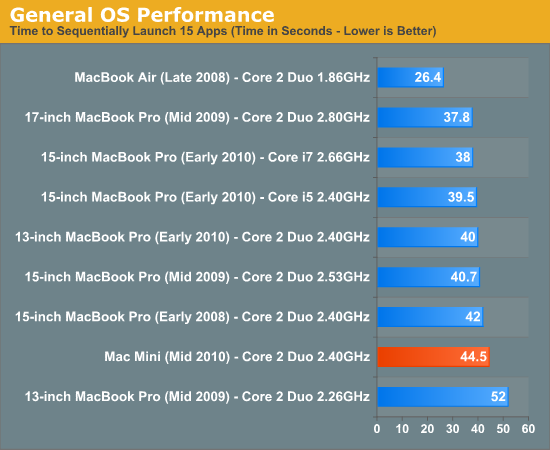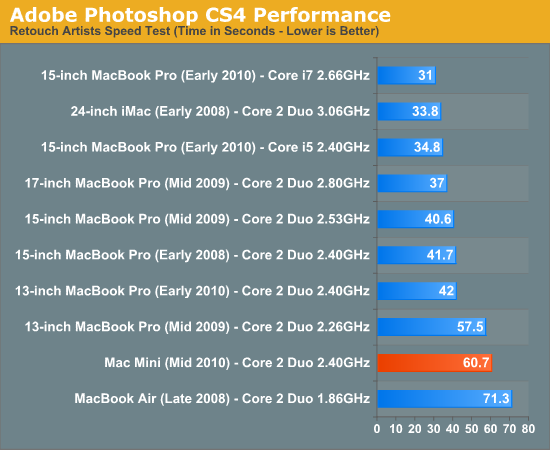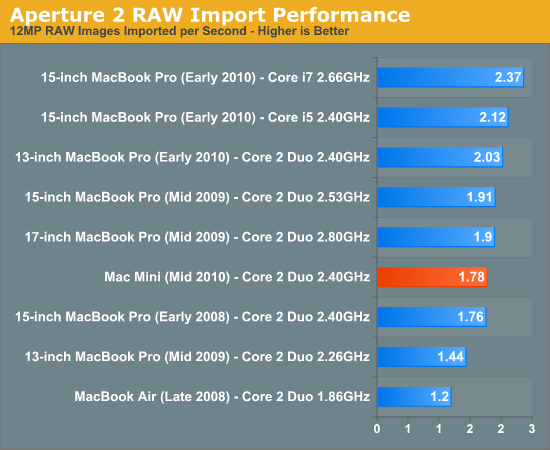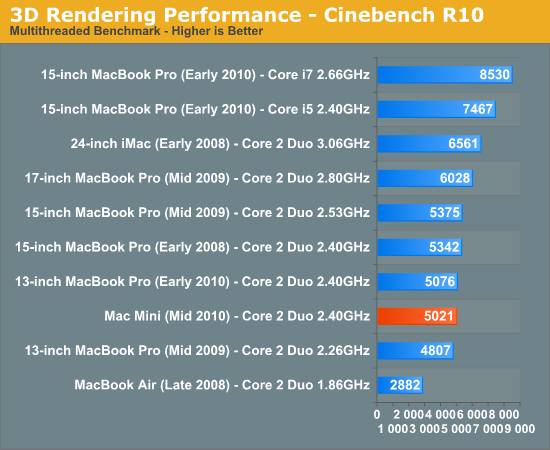Apple Mac mini Review (Mid 2010)
by Anand Lal Shimpi on August 9, 2010 3:37 AM ESTGeneral Performance
The original Mac mini was fast enough for the entry level Mac user back in 2005. Given that Apple’s iPad is fast enough for many users today, I don’t think it’s too difficult to understand that the 2010 Mac mini is sufficient for most needs.
There are two problems with the overall performance of the mini that will contribute to it feeling slow, particularly over time. The first is memory, and I’ll touch on this in more detail later, but 2GB of RAM is simply not sufficient for a computer running a heavyweight OS. Even light multitasking exposes this weakness. The second is the hard drive.
Apple ships the Mac mini with a 2.5” 5400RPM notebook drive. The drive keeps power consumption and noise down to a minimum, while being awful for performance. To Apple’s credit, OS X does a good job of caching frequently used data but without enough RAM this is a wobbly crutch.
The Mac mini is absolutely begging to have an SSD, and unlike the rest of Apple’s Mac lineup, one isn’t even offered on the mini. I’m going to take this opportunity to again plead for Apple to include a decent SSD in its customization options. These days the name of the game is SandForce. While that may change in another quarter or two, we still need Apple to take SSDs more seriously than it has been.
Now on to the numbers. I didn't have any previous generation Intel Mac minis on hand so the performance comparison is mainly to the MacBook/MacBook Pro. I did throw in some results from the early 2008 iMac I reviewed a while back.
General OS Performance
General OS usage is a difficult thing to quantify, but one measure of performance has always been the number of bounces an icon in the dock makes before an application loads. I decided to take it to the next level and write a quick script to launch 15 applications in a row, timing how long the entire process takes.
I launched, in order: Mail, Safari, Activity Monitor, iTunes, iCal, DVD Player, iPhoto, Photo Booth, Quicktime Player, Disk Utility, Preview, iMovie, Front Row, Garage Band and Aperture.
The entire process stresses both the disk and CPU, which is why we see a huge improvement when going to an SSD as well as differences between CPU speeds.

Application launch performance is slower than the 13-inch MacBook Pro because of the mini’s 2GB of memory. You’ll see this trend continuing as we go through our tests.
Adobe Photoshop CS4 Performance
The Retouch Artists Speed Test we use for our CPU testing under Windows also works under OS X. We're running the exact same benchmark here, basically performing a bunch of image manipulations and filters and timing the entire process.

Photoshop performance is decent, but again behind the latest MBPs because we’re swapping to disk. Not only does the mini ship with 2GB of memory but it has to share 256MB with the GeForce 320M.
Aperture 2 RAW Import
For my Aperture test I simply timed how long it took to import 203 12MP RAW images into the library.

Our Aperture test is heavier on the I/O and thus narrows the gap between the 13-inch MBP and the mini.
Cinebench R10
I’m a fan of the Cinebench test because it lets me show off both single and multithreaded performance in the same workload. First, the single threaded performance:


If we’re totally CPU bound, which is the case with Cinebench, you’ll see that the mini performs no differently than the 13-inch MacBook Pro. Compared to a mobile Core i5 you’re looking at roughly 70% of the performance. It’s fast enough, but not speedy.
Quicktime H.264 Video Encoding
Our final benchmark is more consumer focused. Here I'm taking an XviD and converting it to an iPhone-supported H.264 format.

Video encoding performance is once again where we’d expect it to be, roughly on par with the 13-inch MacBook Pro. The new i5 systems are 60% faster.
Maintaining Profit Margins: 2GB vs. 4GB RAM
The $699 mini is the only Mac that currently ships with less than 4GB of memory (except for the MacBook Air). For a $700 system, that’s unacceptable. For a machine that’s sold in 2010, that’s unacceptable. For something that’s not a nettop, well, you get the idea.
The performance gain you see from just adding another 2GB of memory to the 2010 mini is huge. Here’s our Photoshop benchmark before and after an upgrade to 4GB:
| 2010 Mac mini Performance | ||||
| 2GB RAM | 4GB RAM | |||
| Photoshop CS4 Retouch Artists Bench | 60.7 seconds | 42.1 seconds | ||
| Cinebench R11.5 CPU | 1.38 points | 1.39 points | ||
That’s a 44% performance increase! The Cinebench results don't show a similar performance improvement since we're fully CPU bound in an test that easily fits in main memory.
You can argue that not all Mac mini owners won’t be running Photoshop, and I’d even agree with you there, but the memory limits come into play as soon as you start running a couple of large footprint applications. The multitasking falloff is sharp on the Mac mini because you only have 2GB of memory and you’ve got a dirt slow 5400RPM notebook hard drive in there.
The Photoshop results are just to show you something quantifiable. The user experience of the Mac mini is noticeably diminished by only having 2GB of memory.
Upgrading the memory is pretty simple. Just twist the pedestal on the bottom, remove the cover and swap sticks:
Apple ships the mini with 2 x 1GB sticks and the GeForce 320M has a dual-channel DDR3 memory controller so you’ll want to upgrade in pairs as well. Apple charges $100 for the upgrade, which isn’t too bad but you’re better off buying the memory yourself and just eBaying what you get with the system.
You just need to buy DDR3-1066 SO-DIMMs, the same thing you’d put in a notebook.










93 Comments
View All Comments
MonkeyPaw - Monday, August 9, 2010 - link
I don't understand why it has to keep getting smaller and smaller. The original Mini is by no means a monster. I remember setting an old FX5900 on my old G4 mini, and I laughed that the card stuck out about 2" on each side.I guess my point is that I would have rather seen Apple boost the specs all around as opposed to shrinking the package (and raising the price). Apple continues to miss the boat (at least my boat, anyway) when it comes to price/features. I just don't think Apple cares about market share. They want to continue to sell overpriced items to a smaller audience. I guess that's fine, as they seem to make nice profits doing so. But the original Mini made me buy my first mac, and eventually I bought an iBook and a dual-G5. The dual G5 became mysteriously crash-happy, and I haven't been back since. Appke just can't draw me back in yet, not with this price/product.
thunng8 - Thursday, August 12, 2010 - link
That is not correct anymore these days. Modern 7200rpm 2.5" hard drives are only marginally hotter than the 5400rpm variety. It would make no difference in a mac mini enclosure.woutersamaey - Monday, August 9, 2010 - link
It would've been nice to read more on the Mac Mini with Mac OS X Server. To my opinion, it looks like an interesting SOHO server. It has faster (2 of them) 7200 rpm disks and 4 GB of RAM.solipsism - Monday, August 9, 2010 - link
Anand wrote, "With no DMI/QPI enabled NVIDIA chipsets, Apple is either going to have to increase the physical size of many of its products to transition to newer Intel CPUs with 3rd party GPUs or live with Intel/AMD integrated graphics going forward. I'm very curious to see how this plays out over the next 12 - 18 months.”There is plenty of space when they remove the ODD. It’s obvious they aren’t going to move to Blu-ray if they haven’t in August 2010 and haven’t even added AACS to Mac OS X.
The ODD is large, slow, prone to breaking and goes unused by most consumers these days. To put it into perspective takes up 25% of the 13” MB/MBP footprint, as well as 5” of port-side space which all Mac notebooks could use.
On top of that, there is no 9.5mm Ultra-Slim Slot-Loading BRD that would be feasible for the needs of a company obsessed with thin.
Honestly, Anand, if they haven’t added AACS to Mac OS X, added the option to their Mac Pros with full-sized ODDs, and left their optical disc authoring apps to rot why would you even expect this to arrive in such a svelte machine as the Mac Mini.
Ratman6161 - Tuesday, August 10, 2010 - link
...because that isn't what this system uses. Take a look at the page in the review where they show pictures of the system torn down and talk about the Nvidia GeForce 320M and go on to say "The 320M has the graphics, memory controller, SATA controller, PCIe and USB interfaces. " The 320M seems to be a common part on Windows based laptops so it's nothing special - but it isn't Intel.larson0699 - Wednesday, August 11, 2010 - link
@solipsism: The new mini also has a server edition ($1k, apple.com/macmini/server), 2 HDD, no ODD, though none of that open vertical space helps the limited real estate of the motherboard itself.@Ratman6161: As far as I can tell, only Apple has used the GeForce 320M thus far -- you may have mistaken that for the GeForce GT 320M, the former being an IGP and the latter a discrete GPU. Notebookcheck is a great place to compare mobile GPUs by specs, 3DMark scores, and their uses among OEMs, and that's where I learned of the similarly named IGP.
mschira - Monday, August 9, 2010 - link
How does the Mac mini fare with a contemporary medium demading game, such as Starcraft 2?Best
M.
jabber - Monday, August 9, 2010 - link
For that price and application I would want a BD drive in it.I mean a BD drive would be what? An extra $50 (real world price) bu then the Apple price would be an extra $200.
Hmmmm.
Johnmcl7 - Wednesday, August 11, 2010 - link
Not just the cost but also a threat to streaming HD content from Itunes which seems to be another reason for not having blu-ray according to Steve Jobs.I agree with you though hence I bought a Dell Studio Hybrid which is a very similar machine in that it uses laptop component but it also has a blu-ray drive - I'm surprised it didn't get a mention at all in the article.
John
PrincePickle - Monday, August 9, 2010 - link
At least Apple is concentraiting on bringing decent GPU's to their lineups. The industry as a whole has been slacking with educating consumers on the benifits of discrete GPU's.